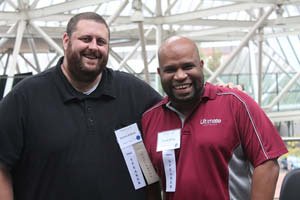Attendee Shares 2018 Conference Takeaways
Attending the annual PNSQC conference can be a tremendous personal learning experience. But what tangible things do attendees take back to the office with them? Anna Sharpe, a QA professional with RiskLens in Spokane, WA, had 3 major takeaways after attending PNSQC 2018 in October.
RiskLens manager Rebecca Long — a 2018 PNSQC paper presenter and reviewer, as well the co-founder of SpoQuality, a monthly meetup of QA professionals in Spokane — encouraged Sharpe to attend the conference this year, and two even drove to Portland together.
When Sharpe returned to Spokane, she began changing her approach to QA, based on speakers’ talks and the topics discussed. Then, in November, Sharpe shared her top takeaways from the conference, with SpoQuality. See if Sharpe’s observations will work in your office as well:
1. Machine learning easily integrates with quality assurance but isn’t always as quickly adopted.

Jason Arbon & Tariq King on ML and testing
Day 1 keynote speaker Tariq King addressed this topic and took it up again later in the conference with Jason Arbon. Sharpe was surprised to learn the extent to which machine learning had found a place at the QA table at some corporations.
“It was really fascinating to everyone, and fun to discuss the possibilities. But, we all work in the real world where we have budgets, and for most of us, it is beyond our reach right now,” said Sharpe. “It was cool to have Ph.D.-level people talk about the industry and what they’re doing. It needs to trickle down a bit and give more value so we can say, ‘We need to buy this because it adds this quantitative value.’”
2. There are still much-debated areas within software testing.
Melissa Tondi’s presentation caught Sharpe’s attention. The Rainforest QA executive’s argument that regression testing should be done by developers — not the QA team — was at odds with Sharpe’s experience.

Melissa Tondi
“At RiskLens, QA people do the regression tests. Tondi said she convinced her company to allow developers to do regression testing. From her perspective they were automated already; developers were clicking the button. In my experience, it’s usually the designers of the tests who run them.”
Sharpe said the SpoQuality group had a lively discussion about delegating elements of testing to developers. A prevailing opinion emerged: that such delegation made sense if a company did not have a fully staffed QA team. But, she said, it seemed like a lot to ask of a developer to also understand and manage QA roles.
“It would be great if they were familiar with testing, but it is a lot of knowledge for one person to have,” Sharpe said.
3. Paired programmers produce better work.
For the second straight year, a keynote speaker addressed this topic. Sharpe found the data to support pair programming offered by Michael Mah compelling enough to bring back to SpoQuality for further discussion. (Keynote speaker Rich Sheridan sang the praises of paired programming in 2017.)
“Mah talked about how paired programming is becoming efficient and cost-effective. I always assumed it was more expensive and slower, but delivered better quality. What he said, with the data he cited, made me think it may be something more of us want to investigate.”
Sharpe said the SpoQuality attendees agreed that there are drawbacks to working with remote partners who may be in very different time zones or who cannot be physically present when a problem arises.
“Working with remote workers can be a huge managerial problem,” she said, “but it appears the downside of paired programming may be going away.”
What was your favorite topic of discussion at PNSQC? Would you add anything to this list? Check out the videos from 2018 and join the discussion below.



